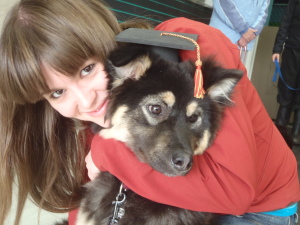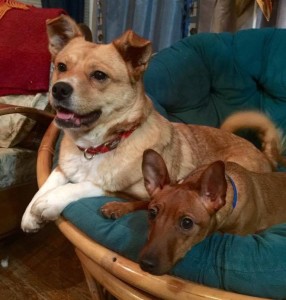by Amanda Kelley*
If you’re like me, sifting through dog training advice is a frustrating experience peppered with guilt. There are so many different methods, and opinions tend to be polarized and emotionally charged. Am I a bad person if I don’t crate train? Are clickers the only way to go? Am I being too strict, or too lenient?
 I’m not a seasoned dog trainer, so fortunately for you, I won’t be hitting you with a training program and series of cutesy acronyms. But I do study animal behaviour, and having run the dog training gauntlet with an unsocialized dog and a critical eye, I believe I can share a few good kernels of advice.
I’m not a seasoned dog trainer, so fortunately for you, I won’t be hitting you with a training program and series of cutesy acronyms. But I do study animal behaviour, and having run the dog training gauntlet with an unsocialized dog and a critical eye, I believe I can share a few good kernels of advice.
When I got my first dog, Hannah, I took a training course where we were not allowed to use treats for motivation, the rationale being that our dogs would treat us like candy dispensers rather than authority figures if food was involved. Hannah and I struggled through the course. Watching the other dogs, I noticed that those who were learning faster were initiating eye contact and behaving as if praise itself was a treat. Hannah, having recently been a stray, showed little response to praise. She didn’t yet know what a smile was, or why it was important. The experience was frustrating, and did nothing for our relationship. Afterwards, I switched to treat-based training. Food is a universal signifier of Good Things, and in our case, it helped Hannah learn my facial and body expressions (obedient Hannah = happy face Amanda = cookies for Hannah). Since then, I have gotten another dog, for whom praise and toys are a much stronger driver than food.
So what can we learn from this experience?

Adoptable Christy May (left) has only recently begun her life as as indoor dog, but she’s willing to try new things!
You don’t have to jump on board with any particular training method. This isn’t like joining a secret society or getting a tattoo: you have the freedom to try different techniques, weigh them, and toss ‘em out if they don’t work. And if they don’t work out, it doesn’t necessarily mean that the trainer is a hack. Dogs, like people, have different personalities and different ways of learning, so a single approach is unlikely to work for every animal.
Observe.
How do you know when it’s working? Or (more likely!) when to give up? Your dog can tell you that, but you’ll probably have to do a little trial and error. For example, a sensitive dog may not respond well to methods on the stricter end of the spectrum. (If it cowers or trembles, you need to tone it down.) However, the same technique that frightens one dog may just bounce off an unruly, confident one. Luckily, dogs have been bred to be good at communicating with us, and with some practice, you can start up a dialogue. Say what you will about Cesar, but in this humble writer’s opinion, a few episodes of Dog Whisperer will help get you in the right frame of mind to think critically about your dog’s body language. And once you can decipher what they’re trying to tell you, and their motivations, you’re well on your way.
Remaining calm is key. Learning a new language isn’t like flipping a switch: it takes time and patience. Your dog won’t pick up on everything right away, and some things may be completely out of their grasp. It’s fine if your dog isn’t perfectly trained; just remember that if you can’t control your dog’s behaviour, you have to control the environment. Does your dog jump on children? Then they need to be supervised. Are they bad at recall? Then they can’t be off leash in potentially dangerous areas. As your control increases, you start to introduce them to more unpredictable environments.
The take home message: Your internet search is not yet over. Do your own research, and try to get a good idea of your options. It’s not a quick fix, but it is the best option for maintaining your sanity.
Have you found a training method that works for you and your pup? If so, please share in the comments below, along with a description of your pup’s personality!
*Amanda Kelley, MSc., is a blogger, web manager, and photographer for Zoe’s. In her professional life, she is a wildlife biologist who specializes in animal personality.






